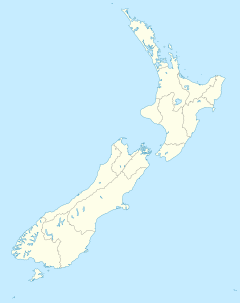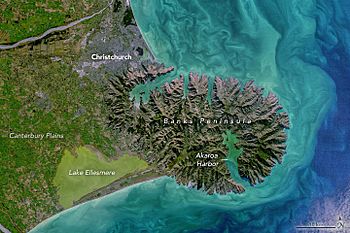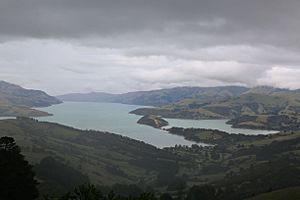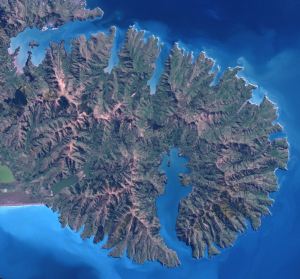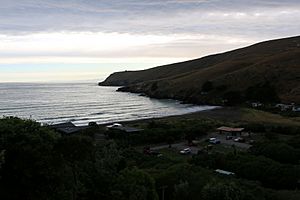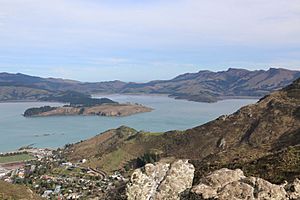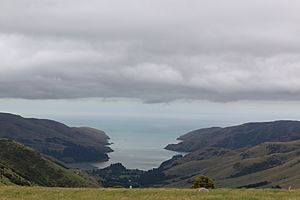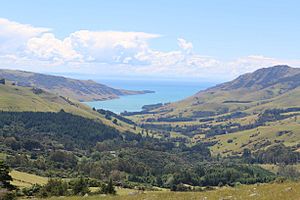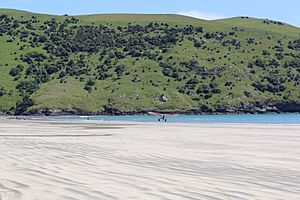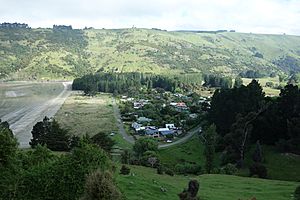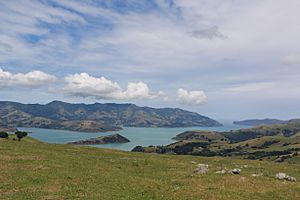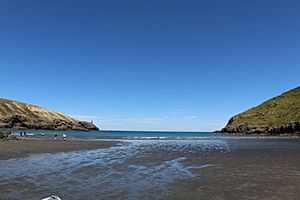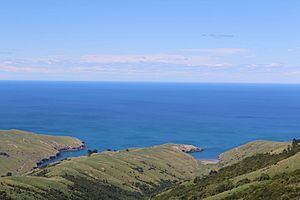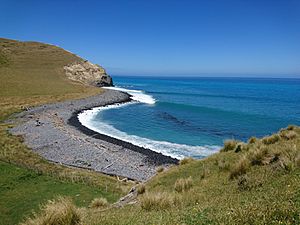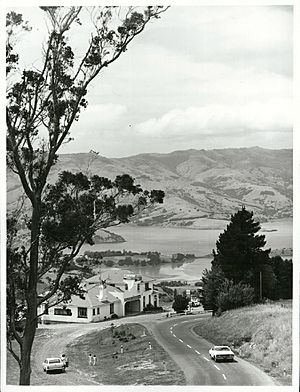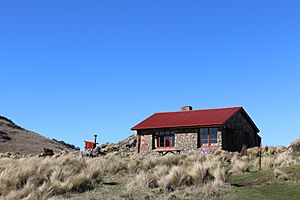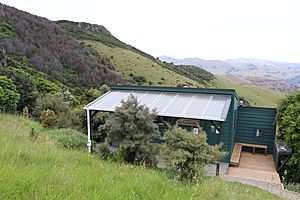Banks Peninsula facts for kids


Banks Peninsula is a peninsula on the east coast of the South Island of New Zealand. It has an area of approximately 1,150 square kilometres (440 sq mi). The peninsula has two large harbours and many smaller bays and coves. The South Island's largest city, Christchurch, is immediately north of the peninsula.
Contents
Geology
The peninsula was formed from the eroded remnants of two large shield volcanoes. These formed between approximately eleven and eight million years ago on a continental crust. The peninsula formed as offshore islands, with the volcanoes reaching to about 1,500 m above sea level. Two dominant craters formed Lyttelton and Akaroa Harbours.
Prehistory
According to tradition the first Māori settlers of the area now known as Banks Peninsula were the Waitaha led by their founding ancestor Rākaihautū. The Māori name for the peninsula is Te Pātaka o Rākaihautū (The Storehouse of Rākaihautū) in recognition of his deeds and the abundance of mahinga kai (foods of the forests, sea, rivers and skies). They were followed by Kāti Māmoe, and then the Ngāi Tahu hapū Ngāi Tūhaitara, who arrived in the 1730s.
History
The first European sighting of the peninsula was on 17 February 1770 by Captain James Cook and crew during Cook's first circumnavigation of New Zealand. Deceived by the outline of higher land behind the peninsula, Cook mistook it for an island and named it "Banks Island" in honour of Endeavour's botanist, Joseph Banks.
In 1809, Captain Samuel Chase, in the sealer Pegasus, corrected Cook's charts by determining that "Banks Island" was in fact a peninsula. His first officer, William Stewart, charted this area of the coast. Pegasus Bay is named after their vessel.
In 1830, the Māori settlement at Takapūneke was sacked, and the local Ngāi Tahu chief, Tama-i-hara-nui captured, by Ngāti Toa chief, Te Rauparaha, with the assistance of the captain of the British brig Elizabeth, John Stewart. It was partly as a result of this massacre that the British authorities sent James Busby, as official British Resident, to New Zealand in 1832.
During the 1830s, several European whaling bases were established on Banks Peninsula. In 1838 Captain Jean François Langlois, a French whaler, decided that Akaroa would make a good settlement to service whaling ships and made a provisional purchase of land in "the greater Banks Peninsula" from 12 Kāi Tahu chiefs. A deposit of commodities in the value of £6 was paid and a further £234 worth of commodities was to be paid at a later period. He returned to France, advertised for settlers to go to New Zealand, and ceded his interest in the land to the Nanto-Bordelaise Company, of which he became a part-owner. On 9 March 1840 he set sail for New Zealand with a group of French and German families aboard the ship Comte de Paris, with the intention of forming a French colony on a French South Island of New Zealand. By the time Langlois and his colonists arrived at Banks Peninsula in August 1840, many Māori had already signed the Treaty of Waitangi (the signatories including two chiefs at Akaroa in May) and New Zealand's first British Governor, William Hobson, had declared British sovereignty over the whole of New Zealand. On hearing of the French plan for colonisation, Hobson quickly dispatched HMS Britomart from the Bay of Islands to Akaroa with police magistrates on board. While Langlois and his colonists sheltered from unfavourable winds at Pigeon Bay on the other side of the peninsula, the British raised their flag at Greens Point between Akaroa and Takapūneke and courts of law convened to assert British sovereignty over the South Island. The French colonists arrived in Akaroa Harbour on 18 August and established a settlement centred on the present-day site of Akaroa. Given that the French colonists had set out for New Zealand on the assumption that they owned the land, the New Zealand authorities made a grant of 30,000 acres to the Nanto-Bordelaise Company, which ceded all rights to the peninsula for £4,500.
During the 1840s, the peninsula and the Canterbury Plains beyond were considered for colonisation, but it took until 1848 for the Canterbury Association chief surveyor, Captain Joseph Thomas to survey the surrounding plains and prepare for the arrival of the Canterbury pilgrims in December 1850.
From the 1850s, Lyttelton and then Christchurch outgrew Akaroa, which is now a holiday resort and cruise ship destination and has retained many French influences as well as many of its nineteenth-century buildings.
Historic harbour defence works dating from 1874 onwards survive at Ripapa Island in Lyttelton Harbour / Whakaraupō, and at Awaroa / Godley Head.
In 2011, the Christchurch earthquakes of Feb and June had their epicentres in the Port Hills, significantly affecting communities.
Economy
Fisheries
Several sites off the coast of the peninsula serve for mariculture cultivation of mussels.
Farming
Farming has been a traditional industry on Banks Peninsula.
Summit Road
The Summit Road forms a notable feature on the peninsula. The road included portions of the early tracks that were built to move cattle around (e.g. the 15 mile track from Akaroa to Pigeon Bay completed in 1844). Much of the construction was completed in the 1880s with more work carried out in the 1930s, the road is in two sections (both of which have views of the area, as well as parks, walkways, and other recreational features):
- one section runs along the crest of the Port Hills from Awaroa / Godley Head (the northern head of Lyttelton Harbour / Whakaraupō) to Gebbies Pass at the head of the harbour.
- the other section runs around the crater rim of Akaroa Harbour from 'Hill Top' – the junction with the main Christchurch-Akaroa highway – to a point above Akaroa.
Conservation
Estimates suggest that native forest once covered 98% of the peninsula. However, Māori and European settlers successively denuded the forest cover and less than 2% remains today, although some reforestation has started. European settlers have planted many English trees, notably walnut.
Hinewai Reserve
Hinewai Reserve, a private nature reserve, has been established on the peninsula to allow for native forest to regenerate on land that was once farmed. It was established in 1987 and now spans 1250 hectares of native bush. it has 40 km of walking tracks through the native bush.
Other protected areas on the peninsula include Ellangowan Scenic Reserve (3.14 km2), designated in 1973, Mount Herbert Scenic Reserve (2.42 km2), designated in 1980, Wairewa Stewardship Area (6.51 km2), designated in 1987, and Palm Gully Scenic Reserve (1.11 km2), designated in 1989.
Marine Reserves
A large Marine Mammal Sanctuary, mainly restricting set-net fishing, surrounds much of the peninsula. This has the principal aim of the conservation of Hector's dolphin, the smallest of all dolphin species. Eco-tourism based around the playful dolphins has now become a significant industry in Akaroa.
The relatively small Pōhatu Marine Reserve centres on Pōhatu / Flea Bay on the south-east side of the peninsula and the larger Akaroa Marine Reserve lies at the entrance to the Akaroa Harbour.
Rod Donald Banks Peninsula Trust
The Rod Donald Banks Peninsula Trust aims to improve public walking and biking access and enhance biodiversity on Banks Peninsula.
They (in 2020) are raising money to purchase 500ha of land including the summits of Mt Herbert/Te Ahu Pātiki and Mt Bradley with the intention to set up a conservation park protecting and restoring native biodiversity. The land is currently farmland but over time the trust intends to return it to native bush. In May 2021, the money was raised to purchase the land. The Rod Donald Banks Peninsula Trust plans to upgrade fencing and remove feral grazing animals.
The Rod Donald Banks Peninsula Trust are also involved in developing Te Ara Pātaka, also known as the Summit Walkway. They have also been involved in providing tramping huts (Rod Donald Hut and Ōtamahua Hut on Ōtamahua / Quail Island) for the public to access.
Banks Peninsula Conservation Trust
Banks Peninsula Conservation Trust was formed in 2001. It works to conserve and enhance the biodiversity and encourage sustainable land management on Banks Peninsula. Work being undertaken in 2020 included work to protect ruru (morepork) and tūī. They also work with landowners to legally protect important biodiversity and landscape values in perpetuity through covenants.
Demographics
Banks Peninsula Ward of Christchurch City Council, which encompasses the area south of the Port Hills, covers 973.13 km2 (375.73 sq mi).
| Historical population | ||
|---|---|---|
| Year | Pop. | ±% p.a. |
| 2006 | 8,166 | — |
| 2013 | 8,235 | +0.12% |
| 2018 | 8,850 | +1.45% |
Banks Peninsula Ward had a population of 8,850 at the 2018 New Zealand census, an increase of 615 people (7.5%) since the 2013 census, and an increase of 684 people (8.4%) since the 2006 census. There were 3,747 households. There were 4,374 males and 4,476 females, giving a sex ratio of 0.98 males per female. The median age was 48.4 years (compared with 37.4 years nationally), with 1,410 people (15.9%) aged under 15 years, 999 (11.3%) aged 15 to 29, 4,710 (53.2%) aged 30 to 64, and 1,728 (19.5%) aged 65 or older.
Ethnicities were 93.1% European/Pākehā, 8.3% Māori, 1.3% Pacific peoples, 3.1% Asian, and 2.0% other ethnicities (totals add to more than 100% since people could identify with multiple ethnicities).
The proportion of people born overseas was 26.8%, compared with 27.1% nationally.
Although some people objected to giving their religion, 58.9% had no religion, 29.0% were Christian, 0.3% were Hindu, 0.5% were Muslim, 0.7% were Buddhist and 3.4% had other religions.
Of those at least 15 years old, 2,400 (32.3%) people had a bachelor or higher degree, and 804 (10.8%) people had no formal qualifications. The median income was $36,000, compared with $31,800 nationally. The employment status of those at least 15 was that 3,807 (51.2%) people were employed full-time, 1,383 (18.6%) were part-time, and 135 (1.8%) were unemployed.
Towns
Akaroa
Akaroa is a small town on the edge of the Akaroa harbour.
Little River
Little River is a small town which sits at the end of the Little River Rail Trail. There are several art galleries, a camp ground, rugby club and primary school there. Wairewa.
Wainui
Wainui is a settlement of mostly holiday houses on the Akaroa harbour.
Wainui can mean 'big water' or 'big river' or 'big bay'. Wainui was once home to a large Ngāti Māmoe settlement. Wainui has important associations for Ngāi Tahu as the bay was then claimed by Te Ruahikihiki for Ngāi Tahu. He made his claim when he landed at Wainui and dug for fern roots there. (This was one of the many traditional ways to claim land). In Ngāi Tahu legend, Tuhiraki (Mt Bossu) which lies behind Wainui, is the resting place of the kō (digging stick) of Rakaihautū. He used this digging stick to dig out many of the South Island lakes.
In 1856, the Wainui Māori Reserve was established and set aside 432 acres for the Ngāi Tarewa Hapū of Ngāi Tahu. In the 1857 census, there was 40 people living there but by 1861, this had declined to 20 people.
A post office was established in 1874, telephone office in 1875, school in 1885 and Presbyterian Church in 1911.
Duvauchelle
Duvauchelle is a small town which sits at the head of the Akaroa harbour.
Diamond Harbour
Diamond Harbour is on Banks Peninsula.
Bays
The inland valleys of the Port Hills known as McCormacks Bay and Moncks Bay are bays of the Avon Heathcote Estuary, rather that coastal bays of Banks Peninsula. Working around the coast from north to south one encounters:
Sumner Bay
Sumner Bay marks the coastal transition from the long sandy beach of Pegasus Bay and the lowlands of the Canterbury Plains to the rocky cliffs of Banks Peninsula. While Sumner is politically and socially considered a suburb of Christchurch, the high Clifton cliffs and the post of volcanic rock on the beach, known locally as Rapanui, or Shag Rock, mark the place where the coastal plains meet the peninsula.
Taylors Mistake
Taylors Mistake is a Christchurch swimming beach with a number of holiday houses lining the bay. Originally, it was known as Vincent's Bay as a result of a Captain John Vincent wrecking his schooner in the bay. It became known as Taylors Mistake in 1853 after another ship wreck in the bay. This time, a Captain Samuel Taylor wrecked his cutter named Hawk at night time. Taylors Mistake is known as Te One-poto in Māori.
Lyttelton Harbour / Whakaraupō
Lyttelton Harbour / Whakaraupō is a harbour within Banks Peninsula. Within the harbour lies Ōtamahua / Quail Island and Ripapa Island.
Port Levy
Port Levy is the most north facing of the bays on Banks Peninsula. It has been visited by Europeans since the 1820s and known as Koukourarata in Māori.
Pigeon Bay
Pigeon Bay has a walking track which follows the eastern side of Pigeon bay out to the head of the bay. It takes about 4 or 5 hours to walk there and back. It has spectacular coastal views. There are a number of holiday homes in Pigeon bay as well as a yacht club and a camping ground. Pigeon Bay most likely gained its name from early whalers seeing the large number of pigeons (kererū) in the forests of Pigeon Bay. The first reference to Pigeon Bay was in 1836.
Captain Langlois celebrated his "purchase" of Banks Peninsula on 9 August 1840 by raising the French flag and conducting a 101 gun salute at Pigeon Bay.
HMS Britomart visited Pigeon Bay towards the end of August 1840 conducting the first hydrographic survey and reinforcing British sovereignty of Banks Peninsula.
Little Akaloa
Little Akaloa is named "little" to distinguish it from Akaroa. It was spelt Hakaroa until 1864. Feral goats have been a problem in Little Akaloa but a successful cull of them in early 2019 is helping eradication efforts on Banks Peninsula.
A moonfish (150 cm long) washed up on the beach at Little Akaloa in 2013. They are more commonly found further north.
Farming around Little Akaloa is a mainstay of the economy. with accommodation providers being a second. Camping at the Little Akaloa Domain is popular in summer. The beach has a boat ramp.
Okains Bay
Okains Bay has a holiday camp ground and a large sandy beach.
Le Bons Bay
Le Bons Bay has a large often empty beach. There is a small settlement of holiday houses. It is surrounded by rolling hills. A river empties into the sea where New Zealand Fur Seals often frolic. First known as Bones bay in 1845, it became known as Le Bons Bay. It is suggested that this was either that a French settler named Le Bon lived there, or that early French settlers called it "The good bay" or that it is a corruption of Bones bay.
John Cuff and William Cudden established a timber mill in Le Bons Bay in 1857. By 1878, the population of Le Bons Bay reached 237. At this stage, the timber had all been milled and the timber mill was moved to Hickory Bay until 1886.
Hickory Bay
Hickory Bay is known as having a beach that provides good surfing. It is east facing. It is known in Māori as Waikerikikari, the Bay of Angry Waters, and was never permanently settled by Māori.
The Ellangowan Scenic Reserve walk is located just below the Summit road in Hickory Bay.
Goughs Bay
Goughs Bay was home to a pā in the 1820s with around 100 people living there. The residents were fugitives from the Kai Huānga feud. In 1830 the pā was attacked by Te Maiharanui and again in 1832 by Te Rauparaha’s raiding parties.
Goughs Bay is most likely named after a whaler, Walter Gough, who was put ashore at the bay in 1836 after an attempted mutiny on the whaling barque Australian. He lived there in the Māori community for many years. Goughs Bay was first referenced in 1858 when Elie Bauriaud, who originally arrived on the Comte de Paris, purchased land there.
Goughs Bay is a well known surfing location and has an exposed beach break that provides consistent surf through out the year.
In 2021, funding was put aside to protect and fence the upper Goughs Bay stream catchment. The aims were to exclude stock, allow native bush to regenerate and improve the water quality. Mataī and tōtara trees will be protected as well as a range of native animals.
A significant rain storm in December 2021 caused damage to the access road to Goughs Bay, with a number of slips making the road impassable. Five weeks later, the road was still closed because of the 34 slips blocking the access road. A report into the Christchurch City Council response to the damage caused by the storm highlighted areas for improvement in how the Christchurch City Council responds to emergencies.
Ōtanerito Bay
Home to a Ngāti Māmoe pā (known as Parakākāriki) and an ancient Māori burial ground, Ōtanerito Bay possibly means "the place of Tane, the fertile one". Home to the Hinewai reserve since 1987. Ōtanerito Bay also formed part of the Banks Track until 2017.
Pōhatu / Flea Bay
Pōhatu / Flea Bay has large colonies of penguins and seals living there, It is home to the Pōhatu Marine Reserve. The Marine Reserve is home to many fish species including triplefins, lumpfish, moki, butterfish, spotties, banded wrasse, blue cod, leather jackets, lobsters, pāua and rockfish.
Akaroa Harbour
Akaroa Harbour is one of the two large harbours on Banks Peninsula. The other being Lyttelton Harbour / Whakaraupō.
Peraki Bay
Peraki Bay is one of the bigger bays on the south west coast of Banks Peninsula. Multiple spellings of Peraki have existed. It was home to a whaling station in the 1830s and 1840s.
Tumbledown Bay/Te Kāio
Tumbledown Bay is considered one of the best beaches near Christchurch. Most people are put off by the drive to get there, hence it is usually very quiet. Tumbledown bay has supported a large Māori population in pre-European times. Numerous archaeological digs have uncovered artefacts including tool fragments, fish hooks, oven stones and seal, Kurī (dog), tuatara, penguin, kiwi, kererū and moa remains in the middens.
There are two small islets at the entrance of the bay named Jachin and Boaz (after the pillars to the Temple of Solomon). These were thought to have been named by Bishop George Selwyn.
In 1911, the Bell Flower (a 98 ton schooner) was wrecked on the cliffs next to Tumbledown Bay.
Te Oka Bay
Magnet Bay
Magnet Bay is known as a spot to go surfing. It has an exposed reef and point break. These provide reasonably consistent surf all year around. The bay is known in Māori as Makara and a pa existed in the bay at one stage. Magnet Bay is named after the Magnet, a 148-ton barque that was shipwrecked in the bay on 3 September 1844. It was sailing under the charge of a Captain Lewis who was travelling from Wellington to Waikouaiti. One person lost their life in the shipwreck.
Mountains
Banks Peninsula includes numerous hills or mountains. Named peaks over 700 metres high include:
Mount Herbert / Te Ahu Pātiki is the tallest point on Banks Peninsula at 919m
Mt Bradley, the second tallest peak on Banks Peninsula at 855m was named after Reginald Robert Bradley who farmed at Charteris Bay from 1858 and also was the vicar of the Parish of Governors Bay and Purau. His oldest son, Orton Bradley, took over the farm which became Orton Bradley Park after his death in 1943.
Mt Sinclair at 841m was named after Captain Francis Sinclair who lived at Holmes Bay. He drowned in 1846 when sailing from Banks Peninsula to Wellington in his schooner Jessie Millar. In Māori, Mt Sinclair is known as Tarawera.
Saddle Hill (841m) befits its descriptive name. The French settlers named it Pitou Comete and the Māori named it Puwaitaha or Ka Mokaikai. Near the summit is a spring known as Te Wai-o-hine-puariari
Mt Fitzgerald (826 metres) overlooks Holmes Bay. It is named after William Fitzgerald who arrived at Pigeon Bay in 1861 and taught at the Pigeon Bay Academy until 1869.
Flag Peak (809 metres)
Stony Bay Peak (806 metres)
Brasenose (785 metres)
View Hill (762 metres)
High Bare Peak (756 metres)
Lavericks (755 metres) and Lavericks Bay could have been named after several people. George Laverick was an early settler in the area. It could also have been named after Captain Laverick of the schooner Lookin which supplied provisions to Akaroa and the Peninsula in the early 1840s. A third explanation is that it was named after Charlie Laveroux, a Frenchman who ended up marooned at the bay by bad weather during a hunting trip. The Māori name for the peak is Ōtepatotu.
Duvauchelle Peak (738 metres) and the town of Duvauchelle were named after the Duvauchelle brothers who arrived in 1840 at Akaroa. They ran a store in Akaroa before departing for South Pacific Islands in 1843.
Mt Evans (703 metres) was named at some point between 1849 and 1850 after First Lieutenant Frederick Evans of the survey paddleship HMS Acheron.
Walking tracks
Banks Track
The Banks Track is a 31 km circular route which starts in Akaroa and visits Flea Bay, Stony Bay and Hinewai Reserve.
Te Ara Pātaka (Summit walkway)
The Te Ara Pātaka (Summit walkway) is a three day tramp that can start at multiple places. The longest routes start either at Gebbies Pass or Kaituna Valley and go to Sign of the Packhorse Hut on the first day. On the second day, trampers follow a track crossing just below Mount Bradley (855 metres) and then ascend Mount Herbert (919 metres) before descending to the Port Levy Saddle. From here it is a short walk to the second overnight stay at Rod Donald Hut. The third day takes in Mount Fitzgerald (826 metres) and Mount Sinclair (841 metres). The track then descends past a 2000 year old giant tōtara in Montgomery Park Scenic Reserve before finishing near the Hilltop tavern on state highway 75.
Le Race
The annual 100 km road cycling race from Cathedral Square in Christchurch to Akaroa traverses Banks Peninsula. The course climbs up Dyers Pass road, follows the summit road along the Port Hills before descending Gebbies Pass to State highway 75. It then ascends to Hilltop before turning off and following the summit road, climbing Duvauchelle peak and descending Long Bays Road into Akaroa. It has been won by three times by Mark Bailey and Michael Vink, twice by Jeremy Yates and Daniel Whitehouse. Hayden Roulston (2016) and Brian Fowler (2005 ) have also won it. In the women's competition Jo Buick, Reta Trotman and Sharlotte Lucas have all won it three times.
Churches
There are a number of historic churches in the valleys and bays of Banks Peninsula. These include
- St John the Evangelist Catholic church, Little River
- St John the Evangelist Anglican church, Okains Bay
- St John the Evangelist Anglican church, Duvauchelle
- St Patrick's Catholic Church, Akaroa
- St Peter's Anglican Church, Akaroa
- Trinity Presbyterian Church, Akaroa
- St Kentigern's Anglican Church, Kaituna Valley
- Wainui Presbyterian Community Church
- St Luke's Anglican Church, Little Akaloa
- Knox Presbyterian Church, Pigeon Bay
- St Paul's Anglican Church, Port Levy
- Church of the Epiphany, Anglican church, Gebbies Valley
- St Cuthbert's Anglican Church, Allandale
- St Peter's Anglican Church, Teddington
- St Andrew's Anglican Church, Little River
- Onuku Anglican Church, The Kaik, Onuku Road, Akaroa
- St Andrew's Anglican Church, Le Bons Bay
- The Church of the Protection of the Mother of God, Le Bons Bay
See also
 In Spanish: Península de Banks para niños
In Spanish: Península de Banks para niños


